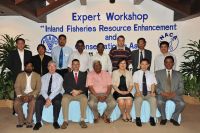This report is the outcome of a study conducted by NACA to assess the shrimp price trends in Vietnam, Indonesia and Bangladesh from January 2008 to June 2009, updating the previous study Evaluation of the impact of the Indian Ocean Tsunami and US Anti-Dumping Duties on the Shrimp Farming Sector of South and South-East Asia, 2006. The previous study highlighted the need for continuous collection of price data at all levels in the supply chain.
This is the manual for the "train the trainers" course aiming to increase the capacity of small-scale farmers in ASEAN countries. The manual focusses on five countries and commodities: Snakehead (Cambodia), Tilapia (Thailand), seaweed (Philippines), marine fish (Indonesia) and shrimp (Vietnam). In this volume, lectures presented by experts are included. The training program included technical aspects related to the culture of commodities, marketing, access to information, organization of farmer groups, gender and good culture practices.
The Asia Regional Advisory Group on Aquatic Animal Health meets annually to discuss regional health issues including emerging disease threats. This report includes a review of regional disease status circa 2009, global and regional disease reporting arrangements, global issues and standards, progress in implementation of the the Regional Technical Guidelines on Health management for the Responsible Movement of Live Aquatic Animals, identification and designation of regional aquatic animal health resources and regional and international cooperation.
Over the past few decades inland fisheries resources have come under increasing pressure from water engineering projects, pollution and overfishing. FAO and NACA convened an expert workshop to review inland fisheries resource enhancement and conservation practices in Pattaya, Thailand, 8-11 February. Experts from 10 Asian countries attended the meeting to share experiences and lessons learned. Regional collaborative efforts are required to facilitate assessment of current inland fisheries resource enhancement and conservation practices.
Inland aquatic ecosystems in China have been largely influenced by the large-scale economic activities and over-exploitation of aquatic resources. A wide range of fisheries resource enhancement and conservation activities have been carried out throughout China. This presentation reviews the history and practices and analyses the problems and insufficient in inland fisheries resource enhancement and conservation in China, and finally recommends some suggestions on technology and operation in order to sustain inland fisheries resources.



